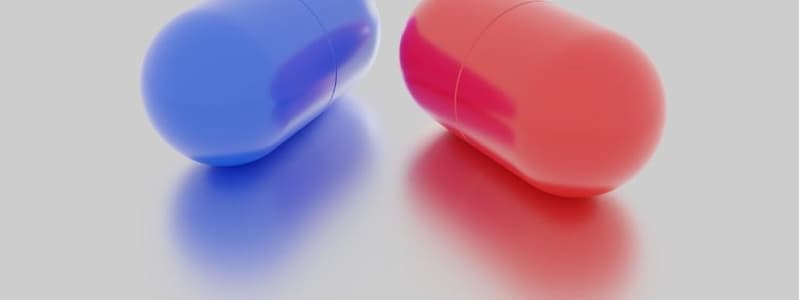Podcast
Questions and Answers
What is the characteristic of the crystalline lens in Microspherophakia?
What is the characteristic of the crystalline lens in Microspherophakia?
- No change in the shape of the lens
- Increased anteroposterior diameter and reduced equatorial diameter (correct)
- Increased equatorial diameter and reduced anteroposterior diameter
- Complete absence of the lens
Which gene is associated with Weill-Marchesani syndrome?
Which gene is associated with Weill-Marchesani syndrome?
- Fibrillins
- ADAMTS10 (correct)
- ADAMTS17
- LTBPs
What is the pattern of inheritance in familial microspherophakia?
What is the pattern of inheritance in familial microspherophakia?
- X-linked dominant
- Both autosomal dominant and autosomal recessive (correct)
- Autosomal dominant
- Autosomal recessive
What is the classic triad of signs in Microspherophakia?
What is the classic triad of signs in Microspherophakia?
What diagnostic procedure may be useful in the diagnosis of Microspherophakia?
What diagnostic procedure may be useful in the diagnosis of Microspherophakia?
What type of imaging technology is used to produce two-dimensional cross-sectional images of the anterior segment?
What type of imaging technology is used to produce two-dimensional cross-sectional images of the anterior segment?
What is the most common sight-threatening complication of microspherophakia?
What is the most common sight-threatening complication of microspherophakia?
What is the treatment of choice for managing complications in microspherophakia?
What is the treatment of choice for managing complications in microspherophakia?
What is a common indication for clear lens extraction in patients with microspherophakia?
What is a common indication for clear lens extraction in patients with microspherophakia?
What is a potential intraoperative complication of clear lens extraction in patients with microspherophakia?
What is a potential intraoperative complication of clear lens extraction in patients with microspherophakia?
Flashcards are hidden until you start studying
Study Notes
Microspherophakia (MSP)
- Characterized by increased anteroposterior diameter and reduced equatorial diameter of the crystalline lens
- Rare condition, usually bilateral
Genetics
- Mutations in genes include:
- LTBPs (family of proteins with structural homologies with fibrillins)
- ADAMTS17 (part of the same family of metalloproteinases as ADAMTS10, associated with Weill-Marchesani syndrome)
Associations
- May occur as an isolated defect, or be associated with systemic/local anomalies
- Entities associated with microspherophakia include:
- Weill-Marchesani syndrome
- Homocysteinuria
- Familial microspherophakia is not associated with systemic abnormalities and has an autosomal recessive pattern of inheritance, but can also be autosomal dominant
General Pathology
- Zonular fibers may be abnormally long and somewhat rudimentary
- Abnormal development and distribution of secondary lens fibers
- Hyaloid degenerations occur due to changes in shape of lens affecting the lens fibers
Pathophysiology
- Mechanisms suggested include:
- Zonular instability leading to lens dislocation/subluxation or secondary angle closure glaucoma
Diagnosis
- Thorough family history and history of systemic anomalies is required
- Symptoms:
- Diminution of vision
- Acute eye pain
- Signs:
- Triad of angle closure glaucoma, shallow anterior chamber, and refractive myopia
- Other findings include:
- Lens dislocation/subluxation
- Zonular instability
- Diagnostic procedures:
- UBM (ultrasound biomicroscopy) for morphological details of anterior chamber angle, iris, ciliary body, zonules, and lens
- Screening tests for associated systemic conditions (e.g. serum homocysteine levels, urine screening test for homocysteinuria)
Complications
- Glaucoma is common in microspherophakia (up to 51% of patients)
- Secondary angle closure glaucoma is the most common sight-threatening complication
- Progressive microspherophakia leads to severe and progressive lenticular myopia
- Zonular instability can lead to lens dislocation or subluxation
Management
- Medical and surgical management of complications can be difficult
- Cycloplegics are the treatment of choice
- Miotics may lead to pupillary block glaucoma
- Stepwise protocol for treatment of glaucoma in microspherophakia:
- Medications
- Laser trabeculoplasty
- Trabeculectomy
- Indications for clear lens extraction in patients with microspherophakia:
- Uncontrolled glaucoma
- Progressive myopia
- Zonular instability
- Intraoperative complications associated with clear lens extraction in these patients include:
- Difficulty in performing capsulorhexis
- Difficulty in implanting IOL due to smaller bag size
Studying That Suits You
Use AI to generate personalized quizzes and flashcards to suit your learning preferences.

